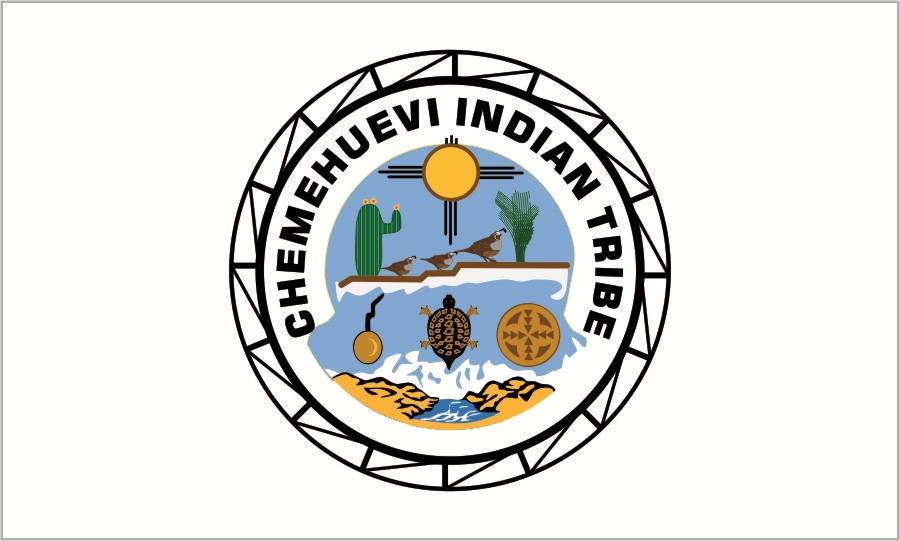
Chemehuevi Tribe Reservation. Source: http://commons.wikimedia.org/wiki/File:The_Chemehuevi_Indian_Reservation_in_Relation_to_Arizona,_California,_and_Associated_Counties.jpg
Chemehuevi Tribe
Reservation[1]
The Tribe was federally recognized in 1970 and is approximately 30,653 acres with 36 miles along the Colorado River and Lake Havasu.[2]The reservation, located in the San Bernardino County of southern California spans the Colorado River into Arizona.[3] The Chemehuevi are the proprietors of the Havasu Landing Resort and Casino located along the shore of Lake Havasu.[4]
Population
The population is between 150 and 345.[5]
Water Resources
Settlement or Decree
Rights for the Chemehuevi—as well as the Cocopah Indian Tribe, Colorado River Indian Tribes, Fort Mojave, and Fort Yuma Indian Reservation—to the Colorado River were established in 1963 by Arizona v. California.[6]
Quantity
In compliance with the 2006 Supreme Court consolidated decree of the 1963 case, Arizona v. California, the Chemehuevi are entitled to divert 11,340-afa per year per from the mainstream, or “the quantity of mainstream water necessary to supply the consumptive use required for irrigation of 1,900 acres and for the satisfaction of related uses, whichever […] is less.”[7] A 2010 request for an additional water pump would add 3,000-acre feet per year in recycled water to the pre-existing diversion rights.[8] It is uncertain whether this request was granted.
Source of Water
Ground wells provide drinking water whereas the Colorado River is the source for the decreed diversion rights.[9]
Use Information
The Chemehuevi utilize their water rights for fishing, agriculture, recreation, and cultural purposes.[10]In 1992, the Chemehuevi joined the Colorado River Basin Tribes Partnership (affiliated with the Ten Tribes Partnership), the purpose of which is for “strengthening tribal influence over the management and utilization of Colorado River water resources.”[11]
Interview
The Chemehuevi Tribe has declined to participate in the interview portion of this project at this time.
Contact:
P.O. Box 1976
Havasu Lake, CA 92362
Phone: (760) 858-4301
Fax: (760) 858-5400
If you would like to learn more about the this tribe, click here to go to their website.
[1] The traditional lands of the Chemehuevi Tribe (sometimes referred to as Nuwu) were declared to be a public domain in 1853 (Chemehuevi History, Chemehuevi Indian Tribe, http://chemehuevi.net/history.php(last visited Apr. 17, 2013). The Chemehuevi Valley Reservation was later created in 1907, but with the establishment of the Metropolitan Water District in 1929 and subsequent Parker Dam Project in 1935, Congress striped the Chemehuevi of much of the Reservation lands (Id.). Five years later, in 1940, 8,000 acres of traditional lands were lost when the floodgates were closed and the land flooded (Id.)
[2] Community Outreach Plan, January 2013 available at http://www.dtsc-topock.com/resources/PublicOutreach/PublicInvolvementPlans/2013-01-11_FinalCOP_Web.pdf.
[3] Chemehuevi Indian Tribal Court, California Courts The Judicial Branch of California, http://www.courts.ca.gov/14781.htm (last visited May 24, 2013).
[4] Supra Chemehuevi History.
[5] Estimate prepared for the Community Outreach Plan prepared for the California Environmental Protection Agency, Department of Toxic Substances Control, January 2013 (Supra Community Outreach Plan).
[6] Id.
[7] Arizona v. California, 547 U.S. 150, 126 S. Ct. 1543, 164 L. Ed. 2d 271, 2006 U.S. Lexis 2703 (2006).
[8] Chemehuevi Indian Tribe Water Tank Project (2010) available at http://portal.hud.gov/hudportal/documents/huddoc?id=2010chemehuevi.pdf.
[9] Chemehuevi Indian Tribe Steering Committee Meeting (Oct. 26, 2011) available at http://www.lcrmscp.gov/steer_committee/meeting_info/111026/res_12-001.pdf
[10] Id.
[11] Ten Tribes Partnership, Colorado River Water Users Association, http://www.crwua.org/TenTribes.aspx (last visited Apr. 17, 2013).
